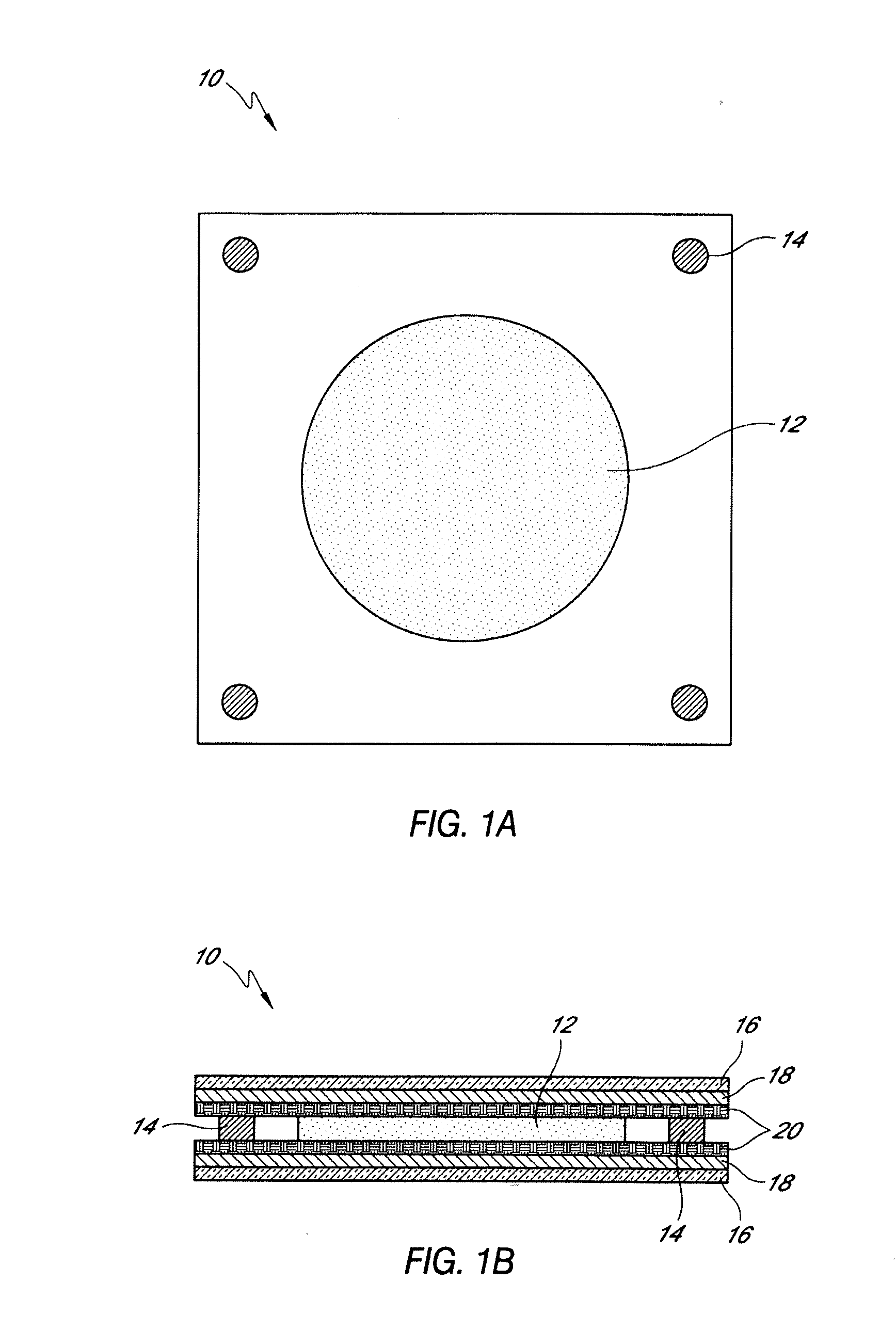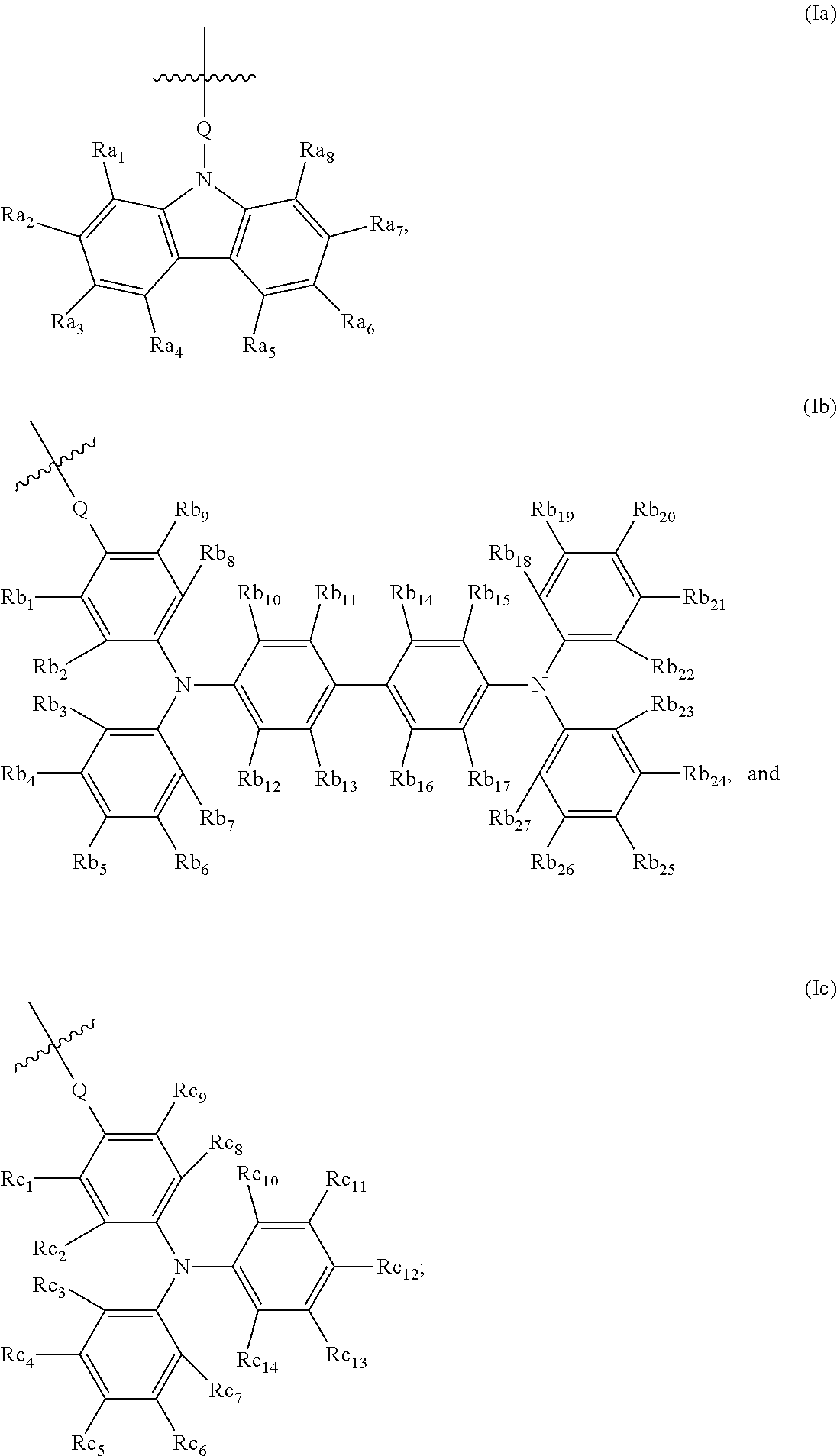Optical devices for modulating light of photorefractive compositions with thermal control
a technology of photorefractive compositions and optical devices, applied in the field of optical devices, can solve problems such as data loss and data disorder, and achieve the effect of good diffraction efficiency
- Summary
- Abstract
- Description
- Claims
- Application Information
AI Technical Summary
Benefits of technology
Problems solved by technology
Method used
Image
Examples
example 1
(a) Monomers Containing Charge Transport Groups
[0097]TPD acrylate type charge transport monomers (N-[acroyloxypropylphenyl]-N,N′,N′-triphenyl-(1,1′-biphenyl)-4,4′-diamine) (TPD acrylate) were purchased from Fuji Chemical, Japan. The TPD acrylate type monomer possessed the structure:
(b) Monomers Containing Non-Linear Optical Groups
[0098]The non-linear-optical precursor monomer 5-[N-ethyl-N-4-formylphenyl]amino-pentyl acrylate was synthesized according to the following synthesis scheme:
[0099]STEP I: Bromopentyl acetate (5 mL, 30 mmol), toluene (25 mL), triethylamine (4.2 mL, 30 mmol), and N-ethylaniline (4 mL, 30 mmol) were added together at room temperature. The mixture was heated at 120° C. overnight. After cooling down, the reaction mixture was rotary-evaporated to form a residue. The residue was purified by silica gel chromatography (developing solvent: hexane / acetone=9 / 1). An oily amine compound was obtained. (Yield: 6.0 g (80%))
[0100]STEP II: Anhydrous DMF (6 mL, 77.5 mmol) was ...
example 2
Preparation of Copolymer by AIBN Radical Initiated Polymerization (TPD Acrylate / Chromophore Type 10:1)
[0106]The charge transport monomer N-[(meth)acroyloxypropylphenyl]-N,N′,N′-triphenyl-(1,1′-biphenyl)-4,4′-diamine (TPD acrylate) (43.34 g), and the non-linear optical precursor monomer 5-[N-ethyl-N-4-formylphenyl]amino-pentyl acrylate (4.35 g), prepared as described in Example 1, were put into a three-necked flask. After toluene (400 mL) was added and purged by argon gas for 1 hour, azoisobutylnitrile (118 mg) was added into the solution. Then, the solution was heated to 65° C., while continuing to purge with argon gas.
[0107]After 18 hrs of polymerization, the polymer solution was diluted with toluene. The polymer was precipitated from the solution and added to methanol, then the resulting polymer precipitate was collected and washed in diethyl ether and methanol. The white polymer powder was collected and dried. The yield of polymer was 66%.
[0108]The weight average and number avera...
example 3
Fabrication of Inert Layer Modified ITO Glass
[0109]About 2.0 g of polymer (amorphous polycarbonate) powder was dissolved in about 20 ml dichloromethane. The solution was stirred under ambient condition overnight to ensure substantially total dissolution. The solution was then filtered through an approximately 0.2 μm PTFE filter and spin-coated onto ITO glass substrate. The film was then pre-baked at about 80° C. for about a minute, and vacuum baked at about 80° C. overnight. The thickness of the inert layer was adjustable to be between about 0.5 μm and about 50 μm, depending on the initial spin-coating speed and polymer concentration.
Production of Optical Device
[0110]A photorefractive composition testing sample was prepared. The components of the composition were provided in approximate amounts as follows:
(i) Matrix polymer (described in Example 2):46.93 wt %(ii) NPP chromophore25.03 wt %(iii) Ethylhexyl carbazole plasticizer25.03 wt %(iv) Anthraquinone sensitizer 3.01 wt %
[0111]To ...
PUM
 Login to View More
Login to View More Abstract
Description
Claims
Application Information
 Login to View More
Login to View More - R&D
- Intellectual Property
- Life Sciences
- Materials
- Tech Scout
- Unparalleled Data Quality
- Higher Quality Content
- 60% Fewer Hallucinations
Browse by: Latest US Patents, China's latest patents, Technical Efficacy Thesaurus, Application Domain, Technology Topic, Popular Technical Reports.
© 2025 PatSnap. All rights reserved.Legal|Privacy policy|Modern Slavery Act Transparency Statement|Sitemap|About US| Contact US: help@patsnap.com



